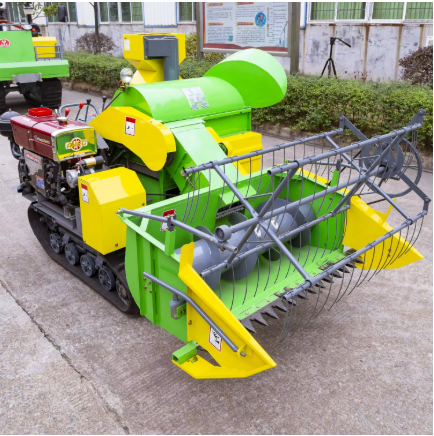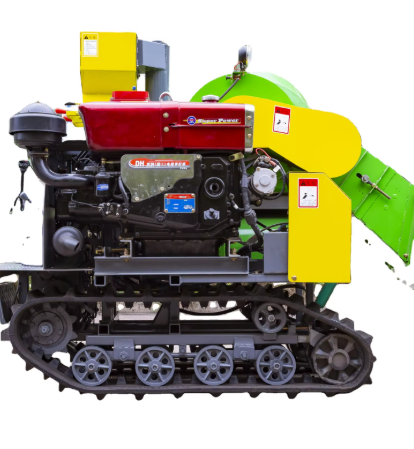Key Differences in Planting Efficiency
Time Requirements per Hectare
Planting rice with machines cuts down the time required per hectare compared to doing it all by hand. Take a mechanized rice transplanter for instance it can finish an acre in about an hour and a half. That's pretty impressive when we compare it to manual planting which needs roughly eighteen workers putting in a full day's work to cover the same ground. Obviously, machines win out here in terms of efficiency. What affects how fast planting gets done? Well, the experience level of whoever is operating the equipment matters a lot, along with what kind of machinery they're actually using. Research shows that folks who know their stuff and have access to newer, better planters can clock in planting speeds that are around 40% quicker than old school methods. The time savings aren't just good for farmers' schedules either this means they can get more land planted in less time, which makes sense given how much rice demand keeps going up these days.
Weather Window Utilization
Farm equipment like mechanical planters gives growers a real edge when dealing with all sorts of weather conditions, something that matters a lot for getting crops into the ground at just the right time. These machines are built to handle everything from soggy fields to bone dry soil, so planting gets done on schedule no matter what Mother Nature throws at them. Farmers across the country are seeing better harvests because these modern planters keep going strong even when rain shows up unexpectedly or drought hits hard. The ability to push through tough weather means farmers aren't sitting around waiting for perfect conditions anymore. They get their seeds in the ground faster, which cuts down on losses from delayed planting seasons and helps protect against bad harvest years.
Root System Preservation
When it comes to root development and soil quality, mechanical planting really outperforms old school techniques. Research shows machines plant seedlings just right in terms of spacing and depth, something that's tough to get consistently when done by hand. The roots stay undisturbed this way, which makes a big difference for how well crops actually grow. Farmers who switch to these precision methods notice their plants handle stress better too. Over time, fields maintain good yields season after season without the ups and downs typical of manual planting. For anyone running an agricultural operation today, investing in mechanical planting equipment isn't just about saving labor hours anymore it's becoming essential for keeping farms productive while being kinder to the land.
Labor Requirements and Workforce Implications
Manual Planting Workforce Demands
Planting rice by hand takes an awful lot of work and needs plenty of people for each hectare. Industry numbers show something crazy actually – sometimes as many as 18 workers are required just to get one acre planted. That kind of number really adds up when it comes to paying wages and makes scheduling planting operations quite difficult too. When planting season hits its peak, finding enough hands on deck becomes a real problem. If there aren't enough workers around, planting gets delayed, which means crops might miss their optimal growing window. These worker shortages don't just push back timelines though. They often result in lower yields because fields aren't planted properly. Young folks today just aren't so keen on doing all that backbreaking work either. Many would rather look elsewhere for jobs, and this has created what some call a quiet crisis in the rice farming community where experienced workers are getting older but fewer young people want to take their place.
Mechanical Workforce Reduction
Switching to mechanical rice transplanters cuts down on how many workers are needed in the field, which means better efficiency when comparing machines to human labor. Some actual field tests show that with these machines, farmers need just three people working per acre instead of dozens, something that would have been unthinkable back when everything was done by hand. This change saves money for sure, but it also shakes up the whole economy in areas where rice is grown. At first glance, having fewer jobs sounds bad for local communities, but there's another side to this story. As farms adopt more technology, new kinds of jobs start popping up too. We're seeing demand grow for folks who know how to fix and maintain these machines, plus there's an increasing need for trainers who can teach farmers how to operate them properly. The overall effect? A different kind of job market emerges alongside traditional agricultural work.

Skill Adaptation Challenges
Bringing rice transplanters into farms means workers need proper training and must adapt their skills to handle this new equipment, which can be particularly challenging in remote rural communities. These machines do offer better efficiency, but getting good results depends heavily on how well operators know what they're doing, so training becomes absolutely essential. Farming groups have started pushing for comprehensive training sessions to help overcome the natural resistance people feel when faced with change. Many older farmers are hesitant about switching from traditional methods, so these programs emphasize hands-on learning where participants actually get to work with the machines. The goal isn't just teaching operation basics either; maintenance skills are included too. This approach helps build long term sustainability in agriculture while meeting the growing demands of contemporary farming practices across different regions.
Cost Analysis: Initial Investment vs. Long-Term Savings
Equipment Acquisition Costs
The money needed at the start is probably the biggest hurdle when switching to mechanical rice planting. These machines definitely cost more than old fashioned hand tools for sure. We're talking anywhere between $3,000 all the way up to $20,000 or more for decent quality transplanters based on what features they come with. Most farmers find this price tag pretty steep initially. But there's some relief out there these days. Many government programs work alongside local cooperatives to provide special loans with lower interest rates or even direct cash assistance through various subsidy schemes. Some regions have pilot projects where farmers can lease equipment instead of buying outright, which makes getting into mechanization much less financially daunting for small scale operations.
Operational Expense Comparison
When rice farmers switch from hand planting to using machines, it really changes how much money they spend running their operations. With mechanical planting, there's just no way around it - labor costs drop because so many fewer hands are needed in the field. Some studies from different regions actually found that one good machine can do the work of about 18 people working manually side by side. Sure, buying and maintaining these machines does cost more at first glance. But look closer and those extra bucks get eaten up pretty quick when compared to what would otherwise go to wages. Farmers tell us all the time that within a season or two, the savings start adding up faster than anyone expected. Less reliance on backbreaking human labor plus the precision these machines bring to the job means real money saved in the pocket over years of farming.
Break-Even Timelines
Figuring out when switching from hand planting to mechanical methods pays off requires looking at how big the operation is and what it costs to run things manually. Most farmers find they break even somewhere between two to five years later, though actual numbers depend heavily on things like how much land they're working, whether yields go up after mechanization, and if they can actually get hold of the right equipment. Bigger farms generally see quicker returns because they benefit from doing things in bulk. Local markets matter too, along with government support programs that might help offset initial costs. What really makes a difference though? Better planting precision means fewer wasted seeds and less money spent on hired hands over time.
Yield Comparison: Machine Precision vs. Human Adaptability
Tiller Count Enhancement
When it comes to rice farming, machine planting really boosts the number of tillers each plant produces, and this generally means bigger harvests overall. Agronomists have found that mechanical systems space out seedlings much more evenly than humans ever could, so each plant gets proper sun and nutrients for good tiller growth. Manual planting just doesn't compare because people tend to leave gaps here and there, which hurts the crop's full potential. Farmers who've switched to mechanized transplanters report seeing real differences in their yields after a season or two. Some fields show increases of 15% or more, which makes sense when looking at how neatly spaced rows allow for better water distribution too.
Grain Weight Optimization
Machine planting brings a level of accuracy that really makes a difference when it comes to grain weight and overall quality, meaning we often see better results in the rice market. When seeds are planted at just the right depth and spaced evenly apart, they grow into rice grains that are more uniform in size and weight. Looking at actual field data from rice quality tests, there's clearly a trend toward heavier grains coming out of fields where machines do the planting. And this matters because heavier grains typically fetch higher prices at market. Farmers who switch to machine planting methods find themselves getting paid more per pound for their harvest, which naturally boosts their bottom line over time.
Field Uniformity Impact
When it comes to getting plants in the ground, machines just do a better job at making sure everything looks even across the whole field compared to when people plant by hand. Those mechanical transplanters can set each seed at exactly the right distance apart and at consistent depths, so all the plants have similar growing conditions. No more patches where there are way too many plants crammed together or spots where nothing much is growing. Research shows that this kind of uniform planting actually cuts down on pests and diseases breaking out, which means bigger harvests at the end of the season. Farmers notice healthier crops when their fields are uniform, and they don't need to spray as much pesticide either. This makes for farming that's easier on both the wallet and the environment over time.
Practical Application Scenarios
Large-Scale Commercial Operations
Big commercial farming operations get real value out of using mechanized rice transplanters. These machines cut down on time spent planting by doing the work faster and more accurately than manual methods. They're especially useful for big fields where farmers need to plant and harvest massive amounts of rice within tight timelines. When farms can take advantage of these machines across their entire operation, they spend way less money on hired labor while still getting better quality crops. Plus, these planters handle different growing conditions pretty well too. Even when weather isn't cooperating perfectly, the machines keep producing steady results. Take what happened in Kenya recently as proof. The collaboration between KiliMOL and the National Irrigation Authority showed how switching to mechanical planting boosted yields dramatically. Farmers went from harvesting around 25 bags per acre to nearly 40 bags after adopting this technology, which speaks volumes about just how effective these machines really are.
Smallholder Farming Realities
Smallholder farmers dealing with mechanization face both hurdles and rewards. Many struggle financially when trying to get their hands on proper equipment, but once they manage to adopt some form of mechanical planting, things change dramatically. Productivity jumps up while the need for manual labor drops off, meaning farmers can work larger areas without breaking a sweat and still see better harvests at the end of the day. Some communities have cracked this code by working together. Take parts of East Africa where groups of farmers joined forces to buy shared tractors and other gear. The results?产量 literally doubled in some cases within just one growing season. Still, money matters and knowing how to operate new machines properly are big deals if these changes are going to stick around long term. Without proper support systems in place, even the best intentions might not translate into lasting success for many small farms.
Mountainous Terrain Limitations
Rice farming gets really tricky when mountains get involved, whether farmers try doing it by hand or using machines. The rough landscape makes things unstable and hard to reach, so equipment needs special tweaks just to work properly at all. Some mechanical fixes have popped up recently too - think wheels that sense the ground beneath them or parts that can be swapped out depending on what kind of slope they're dealing with. A lot of research goes into making sure these new transplanting machines actually work well without losing their speed or reliability. Right now most folks still stick with manual planting methods in steeper areas because they're just easier to manage, but there's been some exciting developments lately. Farmers in places like Nepal and Vietnam are already testing out prototypes that plant rice with pinpoint accuracy across rocky hillsides. These kinds of tech improvements matter a ton if we want mountain communities to catch up with the rest of the world in terms of farming productivity.
FAQ Section
What are the main benefits of using a mechanized rice transplanter?
Mechanized rice transplanters significantly reduce planting time per hectare, lower labor demands, and adapt better to varied weather conditions. They improve planting precision, enhance tiller count and grain quality, and promote field uniformity.
How does mechanized planting affect labor costs?
Mechanical planting greatly reduces labor costs by requiring fewer workers per acre compared to manual methods. This change can reduce workforce needs from 18 people to as few as three per acre.
Are there any financial supports available for adopting mechanical rice transplanters?
Yes, many governments and agricultural agencies offer financing options, subsidies, and grants to help farmers with the initial costs of acquiring mechanized planting equipment.
What challenges do smallholder farmers face when adopting mechanization?
Smallholder farmers often face economic limitations and restrictive access to advanced machinery. Cooperative models, government subsidies, and training programs are critical to supporting the transition to more efficient mechanized practices.

